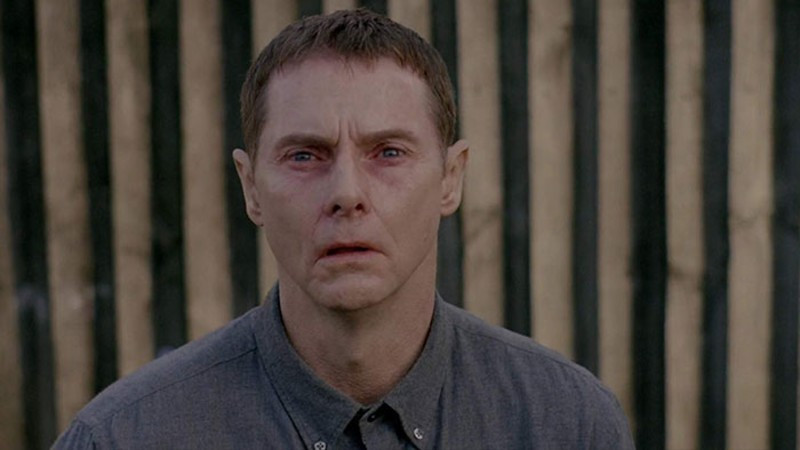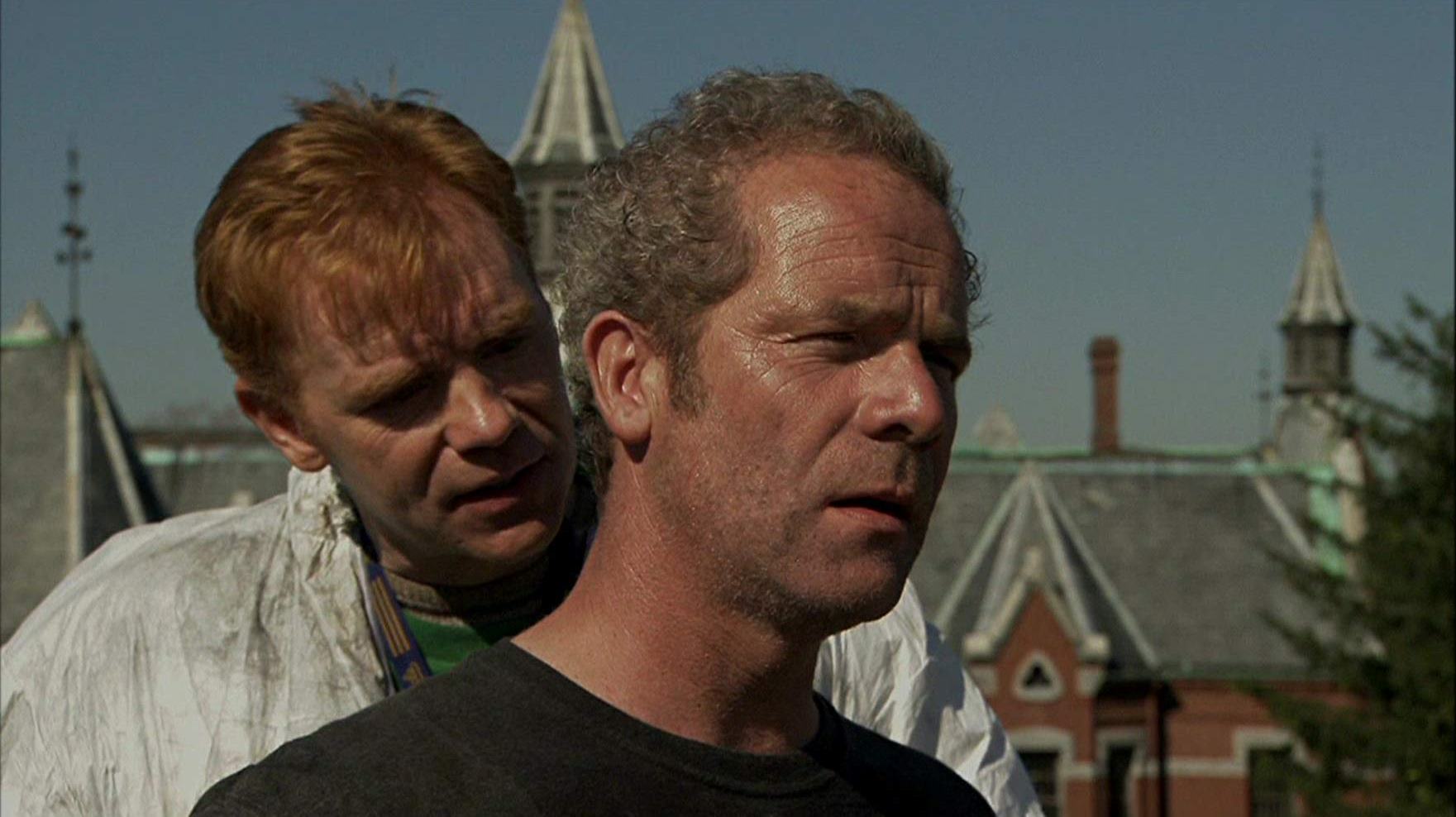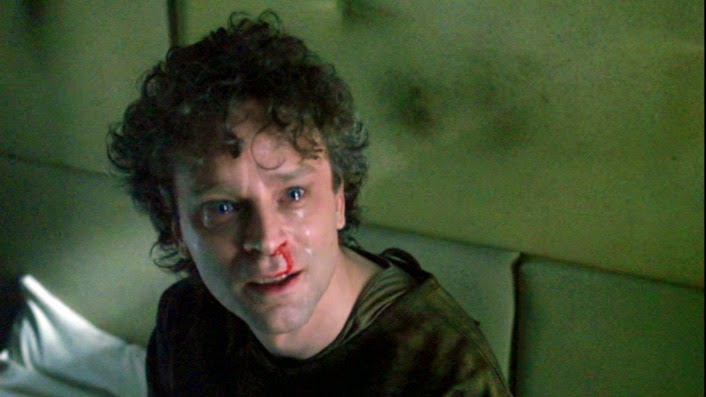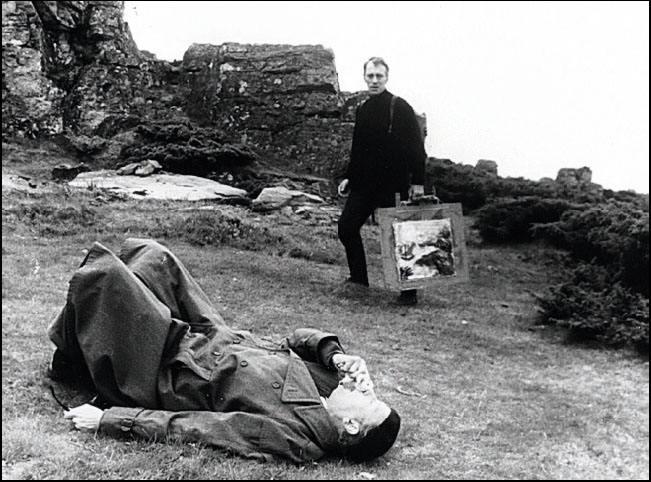6. Possum (Matthew Holness, 2018)

A truly unusual picture, the independent film ‘Possum’ flew under many radars following its release in 2018, but it is a psychological powerhouse packed with symbolism and frightening imagery.
The film follows Philip (Sean Harris), a puppeteer fired from his job under mysterious circumstances. Always accompanying the subdued Philip is a worn leather travel bag in which a horrifying-looking puppet stirs. One is forced to watch as Philip desperately attempts to discard the strange puppet by any means necessary. Yet the grotesque puppet reappears every single time, and Philip is unable to shake it.
Similarly to ‘Deep Red’, a nursery rhyme acts as the creepy thread sewing the pages of ‘Possum’ together, foregrounding the film with an eerie subversion of the familiar formula of our childhood fables. This eerie overtone is enforced by skin-crawling arachnophobia-inducing imagery and a doleful, meandering performance by Harris that meets the tone of the movie perfectly.
Holness’ tale, adapted from his own short story of the same name, is a unique snapshot of the insidious ways in which the horrifying effects of childhood abuse can manifest as later in life. For Philip, the ghastly, green-tinged face of his puppet with his eight furry legs is the metaphoric monstrosity that he must bear, always returning despite his best efforts. It is initially something of a slow burn, but this only adds to its insidious atmosphere. It is sure to give the viewer much food for thought; it may even burrow deep under one’s skin.
7. Session 9 (2001, Brad Anderson)

At first glance, ‘Session 9’ appears as a perfect precursor to the found footage film ‘Grave Encounters’. It seems, on its surface, to play out like any other horror film set in an abandoned mental institution from yesteryear. Following a boom of films of this kind in the mid-2000’s, the format is all-too familiar to us now. But during the release of Session 9, there remained a freshness in the uncharted territory of this sub-genre which blossomed with some truly unnerving concepts.
‘Session 9’ follows a group of construction workers contracted to renovate an old asylum. The task is gargantuan, but the movie’s brooding protagonist Gordon (Peter Mullan) insists on undertaking the heavy workload in a bid to save his strained relationship with his wife. The asylum soon coaxes a series of unexpected behaviours from within Gordon that result in expressions of worry from his co-workers.
Similarly to ‘Mother’, ‘Session 9’ takes its viewer through many unexpected corkscrews of narrative, suggesting then inverting, proposing then promptly doubling back on the initial steer of its own plot. The viewer may develop many theories about what exactly is going on between the group of construction workers, but it’s more than likely that the film is a step ahead.
The film is spliced with suggestions of the paranormal, but the terror in the film is profoundly human and deeply psychological. Don’t be fooled by the horror-style coating of ‘Session 9’. Beneath its eerie exterior lies an interesting and disturbing psychological conundrum for the viewer to sift through.
8. The Exorcist III: Legion (William Peter Blatty, 1990)

The ‘Exorcist’ sequels are eclipsed by their ground-breaking originator, and rightly so. While 1973’s ‘The Exorcist’ remains an undisputed cinematic titan, the franchise’s third film comes with a surprising amount of merits in the wake of the disastrous ‘The Exorcist II: The Heretic’.
The third instalment owes much of its storytelling success to its large diversion in tone to the original. Despite commencing shortly after the conclusion of ‘The Exorcist’ and linking heavily to events in the first act, the power of ‘Legion’ lies more in its focus on psychological trickery, rather than an overt use of demonic imagery, for providing the bulk of its subject matter.
While it retains many horror elements, being credited with one of the greatest jump-scares of all time, ‘Legion’ gives way to an astonishingly emotional battle of wits between a disturbed killer (Brad Dourif) and an aging detective personally connected by both faith and friendship to the case at hand (George C. Scott). This pitting of an upstanding man questioning his faith against the mind of a vicious murderer is swimming with interesting trains of implicative thought, brought to dizzying heights by some freaky imagery and distortions of Catholic symbols.
Elevated somewhat by its supernatural flare, ‘Legion’ may not be as successful a film as its predecessor despite what its director Blatty says, but its deep intermingling of psychological games and faith makes for a fascinating companion film. The less said about ‘The Heretic’, the better.
9. Hour of the Wolf (Ingmar Bergman, 1968)

Stirring in the shadows of ‘Persona’ is Bergman’s tale of isolation. ‘Hour of the Wolf’ follows a married couple as they spend the summer on an island to allow the husband Johan (Max Von Sydow) to paint and focus on his work. As time elopes, the diligent wife Alma (Liv Ullmann) uncovers diaries in which her husband confesses to witnessing strange illusions of people once known to him.
Upon viewing this arthouse gem, it becomes easy to see where Robert Eggers received most of his inspiration for his twin tale of island-bound isolation in ‘The Lighthouse’. The strange dream-like imagery is made all the more ethereal by the swift change of the summery island’s sunny days to cold, windy nights filled with the rattling branches of bare trees. Johan’s states of illusion are packed with creepy imagery, particularly that of the aristocrats of the island’s castle walking on walls in a mind-bending shot by Bergman towards the film’s climax. The film’s cinematic aesthetic is perhaps its most effective aspect.
Bergman’s ‘Hour of the Wolf’ is another psychological test on the viewer, weaving in between the phantoms of Johan’s mind and Alma’s clawing, frantic efforts to save him from the clutches of his demons. It’s not a film for everyone; its often-ambiguous narrative and unexplained character appearances without clear references to Johan’s past can be a little frustrating at times. It eventually rectifies itself, but its first act is something of a hard slog. Nevertheless, ‘Hour of the Wolf’ remains of Bergman’s more vulnerable pictures that has sadly been minimized by his other more culturally resonant masterpieces. It is also a sad but poignant piece of celluloid echoing one man’s demise into madness by way of loneliness and fear, despite the best efforts of his partner to tether him to her.
10. Peacock (Michael Lander, 2010)

‘Peacock’, despite its brilliant performances, has been unfairly glossed over by both viewers and critics alike. Starring Cillian Murphy in a career highlight among a string of phenomenal performances, ‘Peacock’ tells the story of John Skilpa, a quiet bank clerk whose extremely secretive lifestyle comes under threat of exposure when a train derails in his front yard.
Murphy’s repressed and stolen performance of a man stowing emotions pent up from childhood trauma is truly mesmerizing. He is accompanied in the film by Ellen Page, who delivers a moving performance as the mother of John’s child, representing the only figure in their close-minded little town who understands him, or at least tries to.
Like ‘Possum’, ‘Peacock’ divulges a fictitious case study demonstrating the psychological impact of child abuse on one’s adult life. One could view ‘Peacock’ as a softer, more empathetic portrayal of mental illness contrary to the brash horror attributed to tales of childhood trauma by the likes of ‘Peeping Tom’ and ‘Psycho’. Unlike these blood-drenched predecessors, ‘Peacock’ is a strangely sad and beautiful picture that displays John’s story as both tragic, disturbing and captivating.